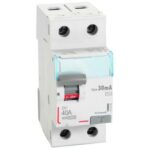SF6 circuit breaker uses sulfur hexafluoride gas as an arc quenching medium. SF6 gas is used because it has high dielectric strength which acts as a good arc-quenching medium. SF6 is an electro-negative gas and has a high capacity to absorb free electrons.
Breakers’ contacts are opened in the high-pressure flow of SF6 gas and the arc is stuck between the breaker’s contact. The free electrons in the arc are suddenly absorbed by gas to form negative immobile ions and the arc gets quenched rapidly.
SF6 circuit breaker is manufactured for voltage ratings from 6.6Kv to 760Kv.It is an inert, non-toxic, non-flammable gas.
SF6 gas has a dielectric strength of 2.35 times that of air at atmospheric pressure.
Table of Contents
Construction Of SF6 Circuit Breaker
It is filled with SF6 gas at pressure 5Kaf/cm^2. The sulfur hexafluoride breaker consists of two parts, mainly the interrupter unit and the gas unit.
The below diagram shows the construction of a puffer-type circuit breaker.

The moving cylinders are attached to the movable conductor against the fixed piston.
As shown in the diagram of the Sulphur hexafluoride breaker with a fully closed position of the interrupter there is the relative movement between the fixed piston and movable cylinder.
Due to this gas is compressed between this contact. This compressed gas in the cavity is released through the nozzle during the arc extinguishing.
Working Principle
Normally breaker contact is closed position when a fault occurs in the power system.
The contacts get separated and the arc is stuck between the fixed contact and movable contact during contact separation, compressed SF6 gas in the cavity is released over the arc and it reduces arc diameter by axial conversion and radial dissipation.
At current zero arc diameter becomes too small and the arc gets extinguished.
Properties of SF6 Gas
Physical properties
- SF6 gas is colorless, odorless
- It is a non-toxic and non-flammable gas
- Nonhazardous
- it is heavy having a density 5 times that of air at a 20-degree temperature
- Has excellent heat transfer property
Chemical properties of SF6 Gas
- gas is chemically stable at standard atmospheric pressure and temperature
- Chemically inert gas
- Non corrosive at ambiant tempreture
- Electro negative gas
- It recombines in a short time after arc extinguish
Dielectric Properties
- The dielectric strength of SF6 gas is 2.35 times that of air at atmospheric pressure.
- At higher pressure dielectric strength of the gas increases.
Advantages
The advantages are as follows
- The size of this breaker is smaller than a conventional circuit breaker of the same rating.
- SF6 gas is non-inflammable and chemically stable hence no danger of fire.
- The required gas is small due to the same gas is recirculated in the circuit.
- Does not make a sound during operation as an air blast circuit breaker due to its closed gas circuit.
- Closed construction avoids contamination of moisture, dust, etc.
- Required less maintenance.
- It can interrupt low and high currents.
- No contact replacement is required due to small contact corrosion
Disadvantages
Disadvantages of SF6 circuit breaker
- The sealing problem arises due to the type of construction
- If the joint does not make perfect gas may leak.
- It is costly due to the high cost of SF6 gas
- Arced SF6 gas is poisonous and should not be inhaled.
Read Also

[…] working principle of a current ELCB, also known as a Residual Current Circuit Breaker (RCCB), is different from that of a voltage Earth leakage circuit breaker. While voltage ELCBs are […]